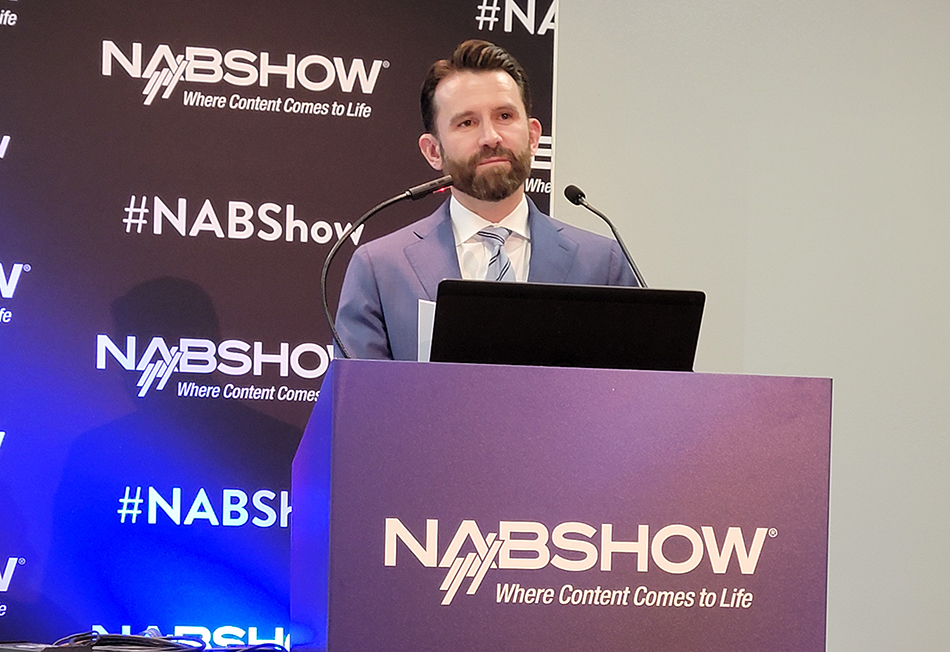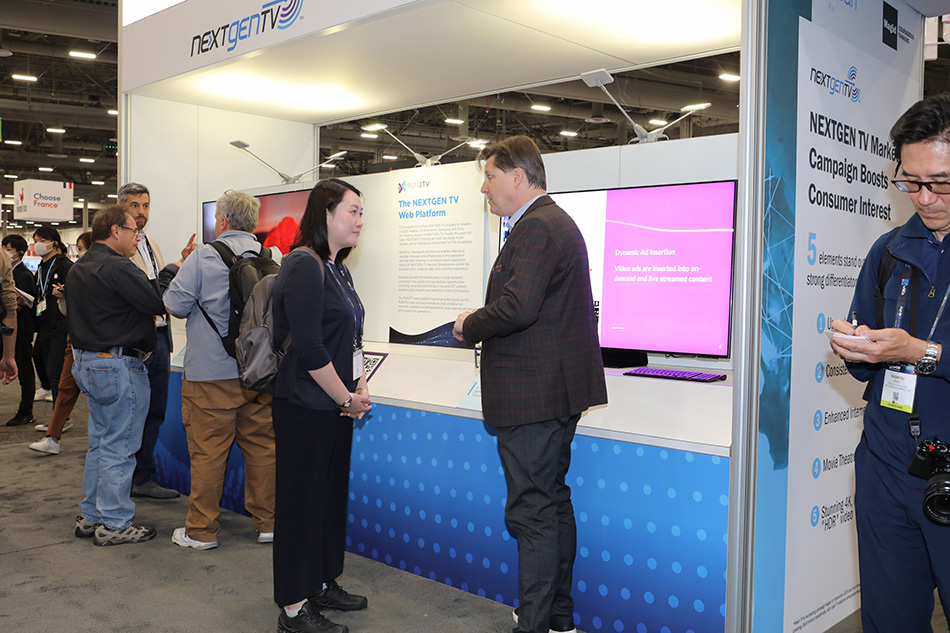NextGen TV Slowly Finds Its Direction
NAB Show highlights ATSC 3.0 spec’s progress in transportation, education

Transportation, education and maybe a few public-sector projects — but relatively scant video ventures — are emerging as the first marketplace realities for Next Generation TV. Although the barrage of supply-side promises from the usual gang of ATSC 3.0 supporters persisted during April’s NAB Show in Las Vegas, actual demand-side implementations are still largely dreams of the future.
Nonetheless, the convention’s parade of announcements and progress reports indicated the array of NextGen TV promises is starting to materialize. In particular:
• Sinclair Broadcast Group plans to field-test video and data features at electric vehicle charging stations in Florida (in collaboration with USSI Global);
• BitPath is introducing its NavPath venture for “precision positioning” and plans to roll out services in Portland, Oregon, and Las Vegas;
• Gaian Solutions is adding 3.0 interactive education features on Curious Crew, a kids show on PBS station WKAR East Lansing, Michigan.
Moreover, NextGen TV cheerleaders in Las Vegas were ecstatic about a new deal with MediaTek, the semiconductor maker known for its systems-on-a-chip (SoC) technology, which will work with the Pearl TV consortium on a “FastTrack to NextGen TV” project. The goal is to accelerate TV set makers’ production of NextGen TV receivers and related devices, including mobile receivers.
Throughout NAB Show, Pearl and other NextGen TV promoters made note of the growing sales of ATSC 3.0-equipped TV sets, which are expected to account for 2% of total U.S. TV sales (4.5 million units) this year, according to the Consumer Technology Association’s latest forecast. CTA predicts sales of such sets to rise to 10% next year and reach an “inflection point” (19% or 15.7 million units) in 2024.
Broadcasting & Cable Newsletter
The smarter way to stay on top of broadcasting and cable industry. Sign up below
The MediaTek commitment “raises the prospects for NextGen TV adoption in more mainstream TVs since so many TV makers use SoC chipsets from MediaTek,” researcher Paul Gagnon, VP at NPD Group and an industry adviser on consumer technology, said. And there were “next generation” follow-on promises in Las Vegas, such as a watermarking pact between LG Electronics and Verance, to enable personalized interactive features in NextGen TV receivers. Separately, Evoca TV, the independent ATSC 3.0 broadcast pioneer, revealed successful tests of a cross-polarization technology that could double the capacity of internet protocol data delivery from a TV channel.
Overall, the NextGen TV presence at NAB Show — which included a
larger-than-ever exhibit area — demonstrated a modicum of progress during the pandemic years. Sales reports from ATSC 3.0 set-makers (still only Sony, LG Electronics and Samsung, with Hisense planning to start production soon) total barely 4 million units to date. Purchasers of high-end TV sets (the ones with NextGen receivers) probably don’t know that 3.0 is built into the devices since there is almost no way to see any programs, Gagnon told B+C Multichannel News.
Revving Up Datacasting
Sinclair Broadcast Group president and CEO Chris Ripley revealed details of a datacasting field trial, transmitting ATSC 3.0 data and video to electric-vehicle charging stations in 28 markets in collaboration with USSI Global, a Florida company that manages network, media, broadcast and digital signage ventures. The project will begin with two charging stations in West Palm Beach, Florida. Resembling existing “gas station TV” pumps at many self-service stations, the USSI Global/Sinclair project will deliver “curated, targeted, unique” programming via the ATSC 3.0 IP data feed from the local TV station. Sinclair owns CBS affiliate WPEC West Palm Beach, Florida.
Gaian Solutions, a Silicon Valley developer of content delivery products for ATSC 3.0 and other platforms, revealed its pilot education project at WKAR, the Michigan State University-owned public TV station. The project uses Gaian’s Mobius Experience Loop for an interactive Curious Crew show, intended to develop interest in STEM (Science, Technology, Engineering, Math) topics among K-12 students.
Ashwini Kotaru, Gaian’s business operations manager, said part of the project involves use of a real-time artificial intelligence system. “The show’s creative and planning team use the analytics data to plan future show topics, formats and further improve engagements,” Kotaru told B+C Multichannel News.
BitPath president and CEO John Hane said “precision positioning” is an important opportunity for ATSC 3.0 data services, among the “large number of projects we’re analyzing that may turn into viable businesses.” BitPath is the operating name of Spectrum Co, LLC, which is owned by Sinclair Broadcast Group and Nexstar Media Group.
At NAB Show, BitPath unveiled its BitPoint and NavPath applications, which it calls “game-changing” position, navigation and timing (PNT) services. They will provide applications to support traffic management, accident control, package delivery and ride-sharing. BitPath plans to launch NavPath in several markets this year with expansion next year to its entire footprint.

Hane cited forecasts that the compound annual growth rate of the PNT sector will surpass 22% for the coming decade, compared to 9% for streaming services. He said BitPath has already begun working with system integrators to develop and enhance features in the “robust marketplace” for navigation, positioning and other services that can use the broadcast spectrum with a “significantly enhanced value.”
BitPath’s first NavPath rollouts will be in Portland and Las Vegas, while it continues to launch ATSC 3.0 in more locations during the rest of this year.
Evoca TV, the Idaho-based hybrid OTA/Internet TV service, revealed that it has just successfully demonstrated the first-ever cross-polarization functionality of the ATSC 3.0 standard. Evoca CEO Todd Achilles said the MIMO (Multiple Input and Multiple Output) feature could double the amount of data that 3.0 signal can convey. The Evoca system, using both horizontally-polarized and vertically-polarized transmission and reception, was successfully tested on its flagship channel in Boise just before
NAB Show.
For its part, Pearl TV said it had launched Run3TV, a web platform based on the A/344 Interactive Content broadcast standard that enables stations to offer hybrid TV services, including interactive and on-demand features, to over-the-air viewers. Pearl TV did not reveal specific markets that will deploy Run3TV technology.
Promises and Perspective
Another indicator of the growing interest in 3.0 is the number of hopeful vendors who are hopping aboard the hype machine. For example Verance, known for its content measurement and enhancement technologies including digital watermarking, announced a deal with LG Electronics to put its ATSC 3.0 “Aspect” watermark firmware into LG NextGen TV receivers.
The watermark technology will enable the 3.0 receiver to offer interactive capabilities, including customized and personalized features such as sports interactivity (hometown announcers and watch parties). Verance CEO Nil Shah said the technology enables the information required for two-way services in a connected smart TV set to pass through any distribution environment, including over HDMI links and through existing distribution equipment and set-top boxes. He said “LG’s embrace of the Verance Aspect watermark will serve as a driving market force.”
Consultant Myra Moore, president of Digital Tech Consulting Inc. in Dallas, said optimism for the NextGen TV transition is widespread, but “getting there is a long process.”
“Broadcasters are setting up the infrastructure,” she said, pointing out that stations recently went through the spectrum repack, which often required building a new antenna. She also points out that as a result of the repack, broadcasters — which compete for business — now recognize they are sharing spectrum, which may generate more appetite by the broadcast licensees to collaborate on new ventures.
She cited Evoca’s subscription NextGen TV projects as an illustration that “someone with good imagination” can demonstrate “there is more than one way to use this standard.”
“There are so many moving parts that haven’t happened before,” Moore said, calling 3.0 “a tool that can do a lot more” than broadcasters have previously been able to offer. She cited data service and other non-traditional offeringss that are forcing the industry to find resources so that they can build and offer new services.
The Broadband View
Coincidentally, the monthly virtual meeting of the Media Institute, a Washington, D.C., think tank, was held on the Tuesday of the NAB Show week (historically, the group — with its core of broadcasting executives and lobbyists — would have avoided such a scheduling conflict). Perhaps, less coincidentally, the speaker was Michael Powell, president and CEO of NCTA–The Internet & Television Association. In response to a question from B+C Multichannel News about the cable industry’s view of NextGen TV, Powell warned the broadcasters’ “ambitious” data objectives “come with risks” that may “pose burdens on other industries and consumers.” ▪️
Contributor Gary Arlen is known for his insights into the convergence of media, telecom, content and technology. Gary was founder/editor/publisher of Interactivity Report, TeleServices Report and other influential newsletters; he was the longtime “curmudgeon” columnist for Multichannel News as well as a regular contributor to AdMap, Washington Technology and Telecommunications Reports. He writes regularly about trends and media/marketing for the Consumer Technology Association's i3 magazine plus several blogs. Gary has taught media-focused courses on the adjunct faculties at George Mason University and American University and has guest-lectured at MIT, Harvard, UCLA, University of Southern California and Northwestern University and at countless media, marketing and technology industry events. As President of Arlen Communications LLC, he has provided analyses about the development of applications and services for entertainment, marketing and e-commerce.

